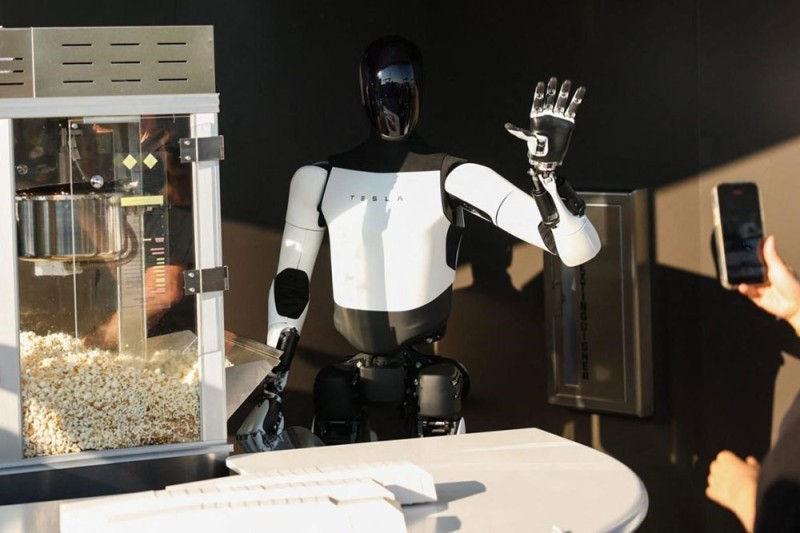
• 特斯拉首席执行官埃隆·马斯克(Elon Musk)认为,人形机器人是决定特斯拉未来的关键所在。这位全球首富周一在社交媒体发文称,特斯拉约80%的市值最终将来自其自主研发的人形机器人擎天柱。特斯拉周一还发布了“宏图计划”第四篇章,进一步强调了物理人工智能的重要性。
尽管机器人生产屡遇阻碍,但埃隆·马斯克对特斯拉的宏大愿景仍聚焦于“减少对电动汽车的关注、全力押注自主机器人”。
这位特斯拉首席执行官周一宣称,终有一天,公司80%的市值将源自人形机器人擎天柱——该人形机器人于2021年推出,旨在承担人类眼中单调乏味且危险的工厂任务。马斯克对机器人成功前景的预测,是在特斯拉周一公布其“宏图计划”第四篇章之后发布的,该计划概述了特斯拉的未来发展目标。
该计划称:“特斯拉故事的下一篇章将助力打造一个我们尚处于初步构想阶段的世界,其体量之宏大,前所未有。我们正通过研发相关产品与服务,引领人工智能走进物理现实世界。”
为专业机器人植入智能,已成为科技领域领导者的核心关注点之一。英伟达(Nvidia)首席执行官黄仁勋(Jensen Huang)同样将“物理人工智能”视为其四阶段演进过程的终极形态,并于近期推出售价3499美元的机器人“大脑”开发套件,本月起开始发货。有分析师指出,马斯克将人形机器人擎天柱视为特斯拉未来的核心,表明特斯拉也有类似的计划。
Zacks Investment Research高级股票策略师凯文·库克(Kevin Cook)向《财富》杂志表示:“埃隆并非唯一一位洞察到机器人与物理人工智能广阔前景的人。显而易见,15年来他一直在用人工智能系统训练特斯拉汽车,因此将业务拓展至其他自主机器领域,对他而言是顺理成章的事。”
对特斯拉而言,实现战略重心转移绝非易事。人形机器人擎天柱自诞生之初便饱受分析师质疑,此后也不断遭遇阻碍。年初时,马斯克曾预测,特斯拉将在2025年生产数千台人形机器人擎天柱,并表示该项目长期有望创造超10万亿美元营收。然而今年四月,马斯克却向投资者表示,该机器人的生产因中美贸易争端而受阻——美方收紧了对稀土材料的出口管制,而这类材料正是制造特斯拉机器人内置电机的关键。负责特斯拉人形机器人擎天柱项目研发的米兰·科瓦奇(Milan Kovac)也已于6月离职。
随着汽车销量持续大幅下滑——7月欧盟地区交付量锐减40%——特斯拉正全力加速拓展电动汽车生产以外的业务。据该公司报告显示,2025年上半年其全球销量下滑13%,且目前正呈现出连续两年销量下滑的态势。
特斯拉未回应《财富》杂志的置评请求。
人形机器人擎天柱面临的竞争日益激烈
尽管特斯拉尚未兑现其在人形机器人擎天柱项目上的承诺,但人形机器人领域的竞争已愈发激烈。摩根士丹利(Morgan Stanley)今年5月发布的研究报告预测,到2050年,人形机器人市场规模将达到5万亿美元,未来25年内全球投入使用的人形机器人数量或将达到10亿台。美国人形机器人公司Figure AI自2022年成立以来,已筹集逾7亿美元资金,投资方包括杰夫·贝佐斯(Jeff Bezos)旗下的Bezos Expeditions、英特尔资本(Intel Capital)、微软(Microsoft)以及英伟达。路透社2月报道称,这家初创公司拟开展一轮规模达15亿美元的融资,若融资完成,其估值将接近400亿美元。此外,总部位于美国加利福尼亚州的K-Scale Labs已研发出一款人形机器人,其单价仅为9000美元,不到人形机器人擎天柱预计起售价的一半。
“(马斯克)当下在机器人领域面临激烈竞争,”库克(Cook)表示,“目前有数十家小型初创公司在做同类产品,不仅成本更低,还采用开源模式——此外还有Figure这类大型公司参与其中。因此,他面临的挑战相当严峻。”
海外市场的竞争更为激烈。汇丰前海(HSBC Qianhai)8月发布的报告显示,2017年至2024年,中国工业机器人销量近乎翻倍,从15万台增至约30万台。中国还大力推进人形机器人的开源开发,这一举措不仅有助于提升其在该领域的行业声誉,还能降低生产成本。
汇丰前海的报告指出:“作为最先进、最受关注的人形机器人制造商之一,特斯拉发布的生产指引被市场视为衡量人形机器人规模化生产推进程度的基准。不过我们认为,市场可能忽视了中国人形机器人供应商取得的进展——相较于海外同行,其商业化进程正在加速推进。”(*)
译者:中慧言-王芳
• 特斯拉首席执行官埃隆·马斯克(Elon Musk)认为,人形机器人是决定特斯拉未来的关键所在。这位全球首富周一在社交媒体发文称,特斯拉约80%的市值最终将来自其自主研发的人形机器人擎天柱。特斯拉周一还发布了“宏图计划”第四篇章,进一步强调了物理人工智能的重要性。
尽管机器人生产屡遇阻碍,但埃隆·马斯克对特斯拉的宏大愿景仍聚焦于“减少对电动汽车的关注、全力押注自主机器人”。
这位特斯拉首席执行官周一宣称,终有一天,公司80%的市值将源自人形机器人擎天柱——该人形机器人于2021年推出,旨在承担人类眼中单调乏味且危险的工厂任务。马斯克对机器人成功前景的预测,是在特斯拉周一公布其“宏图计划”第四篇章之后发布的,该计划概述了特斯拉的未来发展目标。
该计划称:“特斯拉故事的下一篇章将助力打造一个我们尚处于初步构想阶段的世界,其体量之宏大,前所未有。我们正通过研发相关产品与服务,引领人工智能走进物理现实世界。”
为专业机器人植入智能,已成为科技领域领导者的核心关注点之一。英伟达(Nvidia)首席执行官黄仁勋(Jensen Huang)同样将“物理人工智能”视为其四阶段演进过程的终极形态,并于近期推出售价3499美元的机器人“大脑”开发套件,本月起开始发货。有分析师指出,马斯克将人形机器人擎天柱视为特斯拉未来的核心,表明特斯拉也有类似的计划。
Zacks Investment Research高级股票策略师凯文·库克(Kevin Cook)向《财富》杂志表示:“埃隆并非唯一一位洞察到机器人与物理人工智能广阔前景的人。显而易见,15年来他一直在用人工智能系统训练特斯拉汽车,因此将业务拓展至其他自主机器领域,对他而言是顺理成章的事。”
对特斯拉而言,实现战略重心转移绝非易事。人形机器人擎天柱自诞生之初便饱受分析师质疑,此后也不断遭遇阻碍。年初时,马斯克曾预测,特斯拉将在2025年生产数千台人形机器人擎天柱,并表示该项目长期有望创造超10万亿美元营收。然而今年四月,马斯克却向投资者表示,该机器人的生产因中美贸易争端而受阻——美方收紧了对稀土材料的出口管制,而这类材料正是制造特斯拉机器人内置电机的关键。负责特斯拉人形机器人擎天柱项目研发的米兰·科瓦奇(Milan Kovac)也已于6月离职。
随着汽车销量持续大幅下滑——7月欧盟地区交付量锐减40%——特斯拉正全力加速拓展电动汽车生产以外的业务。据该公司报告显示,2025年上半年其全球销量下滑13%,且目前正呈现出连续两年销量下滑的态势。
特斯拉未回应《财富》杂志的置评请求。
人形机器人擎天柱面临的竞争日益激烈
尽管特斯拉尚未兑现其在人形机器人擎天柱项目上的承诺,但人形机器人领域的竞争已愈发激烈。摩根士丹利(Morgan Stanley)今年5月发布的研究报告预测,到2050年,人形机器人市场规模将达到5万亿美元,未来25年内全球投入使用的人形机器人数量或将达到10亿台。美国人形机器人公司Figure AI自2022年成立以来,已筹集逾7亿美元资金,投资方包括杰夫·贝佐斯(Jeff Bezos)旗下的Bezos Expeditions、英特尔资本(Intel Capital)、微软(Microsoft)以及英伟达。路透社2月报道称,这家初创公司拟开展一轮规模达15亿美元的融资,若融资完成,其估值将接近400亿美元。此外,总部位于美国加利福尼亚州的K-Scale Labs已研发出一款人形机器人,其单价仅为9000美元,不到人形机器人擎天柱预计起售价的一半。
“(马斯克)当下在机器人领域面临激烈竞争,”库克(Cook)表示,“目前有数十家小型初创公司在做同类产品,不仅成本更低,还采用开源模式——此外还有Figure这类大型公司参与其中。因此,他面临的挑战相当严峻。”
海外市场的竞争更为激烈。汇丰前海(HSBC Qianhai)8月发布的报告显示,2017年至2024年,中国工业机器人销量近乎翻倍,从15万台增至约30万台。中国还大力推进人形机器人的开源开发,这一举措不仅有助于提升其在该领域的行业声誉,还能降低生产成本。
汇丰前海的报告指出:“作为最先进、最受关注的人形机器人制造商之一,特斯拉发布的生产指引被市场视为衡量人形机器人规模化生产推进程度的基准。不过我们认为,市场可能忽视了中国人形机器人供应商取得的进展——相较于海外同行,其商业化进程正在加速推进。”(*)
译者:中慧言-王芳
• The future of Tesla lies with its humanoid robots, according to CEO Elon Musk. On Monday, the world’s richest man wrote on social media that about 80% of Tesla’s value would eventually come from its autonomous Optimus bots. Tesla on Monday also released its “Master Plan, Part IV,” which put increased emphasis on physical AI.
Elon Musk’s lofty vision for Tesla includes less attention on electric vehicles and a doubling down on its autonomous robots, even as production for the bots have hit numerous snags.
The Tesla CEO said on Monday 80% of Tesla’s value would someday come from Optimus robots, the humanoid bots Musk’s company introduced in 2021, intended to take on the factory tasks that humans find menial and often dangerous. Musk’s forecast of the bots’ success came shortly after Tesla revealed its “Master Plan, Part IV” on Monday, outlining Tesla’s goals for the future.
“This next chapter in Tesla’s story will help create a world we’ve only just begun to imagine and will do so at a scale that we have yet to see,” the plan said. “We are building the products and services that bring AI into the physical world.”
Investment in adding embedded intelligence to specialized bots has been top of mind for tech leaders. Nvidia CEO Jensen Huang has similarly singled out “physical AI” as the final iteration of AI’s four-part evolution, recently introducing a $3,499 developer kit for robot “brains” that begins shipping this month. Musk’s emphasis on Optimus robots as the future of Tesla is signaling a similar agenda, according to one analyst.
“Elon is not alone in seeing the big future of robotics and physical AI,” Kevin Cook, senior stock strategist at Zacks Investment Research, told Fortune. “He’s been obviously training his Tesla cars for 15 years with AI systems, and so it’s only natural for him to move into other autonomous machines.”
Shifting gears has not been easy for Tesla. The Optimus robots were initially greeted with skepticism from analysts and have continued to encounter obstacles. At the beginning of the year, Musk predicted Tesla would manufacture thousands of Optimus bots in 2025 and said the project could generate more than $10 trillion in revenue in the long term. In April, however, Musk told investors production of the machines was hobbled by President Donald Trump’s trade disputes with China, which hardened export controls on the rare-earth materials necessary to build the motors inside Tesla’s bots. Milan Kovac, who oversaw Tesla’s Optimus development, stepped down from his role in June.
Tesla’s increased focus on growing the company outside its EV production comes as car sales continue to plummet, with deliveries in the European Union plunging 40% in July. The company reported a 13% global sales decline in the first half of 2025, on pace for a second consecutive year of dwindling sales.
Tesla did not respond to Fortune’s request for comment.
Optimus’ growing robot competition
While Tesla has yet to deliver on the promises of its Optimus project, the sector of humanoid robots has become increasingly crowded. Morgan Stanley research predicted in May the humanoid market would reach $5 trillion by 2050, with the possibility of 1 billion bots being in use in a quarter century’s time. Figure AI, an American humanoid-robot company, has raised more than $700 million since its 2022 founding, including from Jeff Bezos’s Bezos Expeditions investment firm, Intel Capital, Microsoft, and Nvidia. In February, Reuters reported the startup’s potential $1.5 billion funding round would put it at a valuation near $40 billion. The California-based K-Scale Labs has developed a bot priced at $9,000 per unit, less than half of Optimus’s projected starting price.
“[Musk] has got so much competition now with robots,” Cook said. “There are dozens and dozens of small startups doing this for cheaper and open-source—and then big players too, like Figure—so he’s got his work cut out for him.”
There’s even more competition overseas. According to an August report from HSBC Qianhai, China’s industrial robot sales have nearly doubled from 2017 to 2024, from 150,000 to about 300,000 units. China also emphasized open-source development, which could help it garner goodwill in the sector and make production cheaper.
“As one of the most advanced and high-profile humanoid robot makers, Tesla’s production guidance was taken by the market as a benchmark for understanding how much progress is being made to manufacture humanoid robots at scale,” the HSBC report said. “Still, we believe the market might have overlooked progress made by Chinese humanoid robot suppliers, where commercialization is speeding up compared to overseas peers.”

